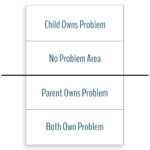…Or in other words, how to mediate conflicts between siblings.
Our two boys (ages 8 and 6) currently enjoy everything related to the Teenage Mutant Ninja Turtles franchise – the shows, the movies, and more recently the action figures, which my wife and I recently got for them. Our older son prefers not so much to play with them, but rather to pose and display the figures with their weapons and other accessories on their play table.
Our younger son, well, he just wants to have imaginary battles with the toys – flying, kicking and jumping them around while using his large repertoire of sound effects. In his excitement and physical play, he would end up losing pieces all throughout the house.
This was certainly not acceptable to our older son who wanted them all in their proper place, and resulted in them fighting and coming to us to resolve this conflict of how they get to play with them and who’s going to find all the missing pieces after they’re done with them.
So what do you do as a parent in this situation? In the P.E.T. book, by Dr. Thomas Gordon, he explains:
This is usually where most parents approach the inevitable and all-too-frequent child-child conflicts with the same win-lose orientation they use in parent-child conflicts. Parents feel they have to play the role of judge, referee, or umpire—they assume the responsibility for getting facts, determining who is right and who is wrong, and deciding what the solution should be. This orientation has some serious drawbacks and generally results in unhappy consequences for all concerned. The no-lose method is generally more effective in resolving such conflicts and much easier on parents. It also plays an important part in influencing children to become more mature, more responsible, more independent, more self-disciplined.
When parents approach child-child conflicts as judges or referees, they are making the mistake of assuming ownership of the problem. By moving in as problem-solvers, they deny children the opportunity to assume the responsibility for owning their own conflicts and to learn how to resolve them through their own efforts. This prevents their children from growing and maturing and may leave them forever dependent on some authority to resolve their conflicts for them. From the standpoint of parents, the worst effect of the win-lose approach is that their kids will continue to bring all their conflicts to the parents. Instead of solving their conflicts themselves, they run to the parent to settle their fights and their disagreements.
So how do parents use the P.E.T. skills when their children have a conflict between them?
Firstly, the key to helping children resolve their conflicts with each other is for the parent to accurately perceive that their children own the problem, not the parent. (Behavior Window – Problem Ownership)
accurately perceive that their children own the problem, not the parent. (Behavior Window – Problem Ownership)
Next, the parent encourages the children to talk directly to each other rather than through the parent and helps each of them express their feelings without blaming the other one. (I-Messages)
The parent refrains from giving advice or opinions, asking probing questions or using any of the other Roadblocks. Instead, the parent Active Listens to both children so they feel accurately understood; and s/he helps each child listen to the other’s point of view. This helps them change their blaming statements (You-Messages) to statements of needs. (I-Messages)
Finally, if the children haven’t already found their own solution by hearing each other’s needs, the parent guides them through the Six Steps of Method III and allows them to come up with their own solutions.
Fortunately, my wife and I have used this process of mediating conflict successfully before with our boys. So in this case, with a little assistance and Active Listening from us, they were able to be heard, listened to each other’s point of view, and came up with a solution that was acceptable to both of them.
Now if our younger son wants to play with the figures, he has agreed to either take off all the accessories before playing with them (he doesn’t necessarily need those in order to have fun with them anyway) or help find any missing pieces if he did use them after he was done. He would then put them all back on the play table. Our older son can then enjoy setting up all the superheroes and villains again and again, ready for their next battle.
Cowabunga, dude! P.E.T. saved the day.

